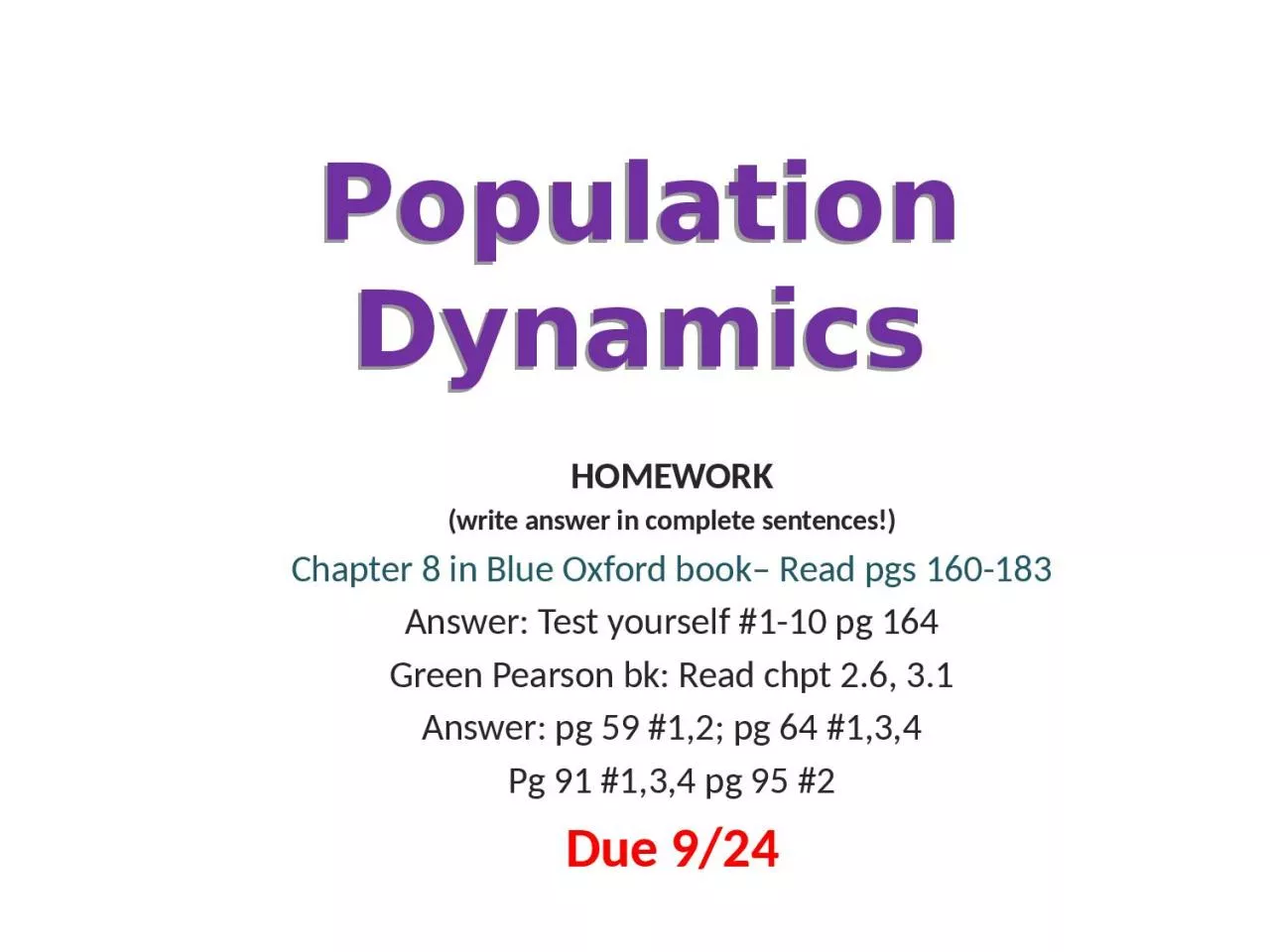

write answer in complete sentences Chapter 8 in Blue Oxford book Read pgs 160183 Answer Test yourself 110 pg 164 Green Pearson bk Read chpt 26 31 Answer ID: 1040616
Download Presentation The PPT/PDF document "Population Dynamics HOMEWORK" is the property of its rightful owner. Permission is granted to download and print the materials on this web site for personal, non-commercial use only, and to display it on your personal computer provided you do not modify the materials and that you retain all copyright notices contained in the materials. By downloading content from our website, you accept the terms of this agreement.
1. Population DynamicsHOMEWORK(write answer in complete sentences!)Chapter 8 in Blue Oxford book– Read pgs 160-183Answer: Test yourself #1-10 pg 164Green Pearson bk: Read chpt 2.6, 3.1Answer: pg 59 #1,2; pg 64 #1,3,4Pg 91 #1,3,4 pg 95 #2Due 9/24
2. Population DynamicsThe study of how a population changes over time and space. Population – a group of individuals from one species that may interbreed and produce offspring.5 key properties of populations : 1. Abundance – size of a population at present time, past and future. 2. Birth rates – how many individuals born within a specific time period. (b = B/N) 3. Death rates – how many individuals die within a specific time period. (d = D/N) 4. Growth rates – birth rate – death rate = net number of individuals 5. Age Structure – the proportion of individuals at each age level with a population.b= birth rated = death rateB= Total # births per time periodD = Total # deaths per time periodN = Population
3. Age structureA closer look:Age structure takes into account the affects many different values.birth/death rates of present and futureimpact on the environmentcurrent and future social and economic conditionsUsually modeled as a graph: 4 basic types Pyramid, column, inverted pyramid, and column w/bulge.
4. Pyramid StructurePopulation at each stage of lifeShort life spanHigh death rate at each endHigh birth rateEx: KenyaOlderYounger
5. Column Structuredeclining birth rateLow death rateStable population or decreasing populationEx: USA bulge in the column occurs if there was in increase in birth or death rates at a certain age group.ie. war, baby boom, etc.
6. Inverted PyramidMore older people than younger.Low death rateLow birth rateLonger life expectancy with good careEx: Many parts of Europe
7. Research – Due You will research your ancestry’s origins.Pick one country from your family’s past (can not be US, unless Native American, then use your Tribe)Research the population from that time period and the current population.Draw/graph two pyramids.1st one showing the population – age structure from your family’s past2nd showing the age structure of the country now.Write a ½ page paper explaining the difference in graphs and what has accounted for the difference, using your knowledge on population dynamics.
8. Growth RatesA closer look:Determined by the change in population over a specific time period.Populations will increase as long as there is nothing stopping them (ie – limiting factors)Most populations will double within a specific time, or generation (ie – exponential growth)
9. Exponential Growth
10. Limiting FactorsPopulation growth will go unheeded if there is an ample supply of space, food and water to sustain the increase in population numbers. (That is, a utopian world with unlimited supplies of all our needs.)But of course we live on earth, so there are limiting factors that play a role in our population size.2 types: density-dependent and density-independent.
11. Density-DependentAll biotic factors are density-dependent.The increase in population size will increase the effect they have on the ecosystem. (negative feedback)Leads to population stability and/or regulation of the populationInternal factors:Factors that effect an individual species.Ex: limited food, availability of habitat area or territory, fertility.External factors:Factors between two different species.Ex: predation and disease.
12. Density-IndependentMost abiotic factors are density-independentPopulations do not effect density-independent factors within an ecosystem, but these factors play a role in regulating the existing populations. (not a feedback mechanism)ex: weather and climate, natural catastrophesGives rise to two population growth patterns:S-curves and J-Curves
13. S-CurvesShows a pattern where the population will increase exponentially until the available resources are starting to max out. At the time the resources or density-dependent factors become limited, the population growth rate will start to slow down until it reaches a constant state. (Seen as an S shape on a graph.)Carrying capacity – the maximum population size in regard to what the environment can support.
14. S-Curve Graph
15. J-Curve Shows a growth and setback type of patternSeen in populations that have grown exponentially then collapsed (dieback)Usually seen in populations that have exceed their carrying capacity (overshoot)Seen in populations that have had a series of growths, but then a natural catastrophe, or war has decreased their population size drastically.Typical in microbes, invertebrates, small mammals (ie gerbils), and fish.
16. J-Curve Graph